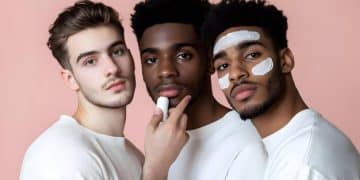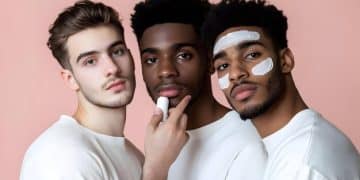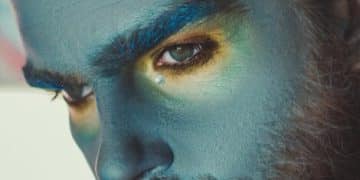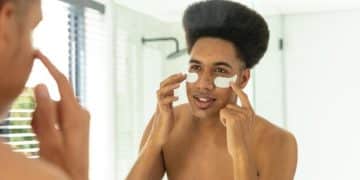Gender-Neutral Makeup: Reshaping Beauty for US Men
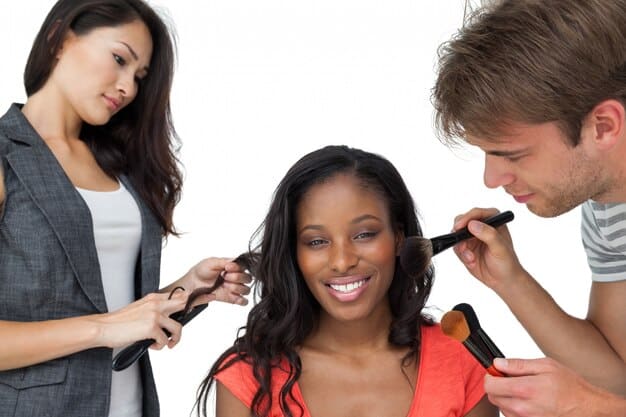
The rise of gender-neutral makeup is profoundly reshaping the beauty industry for men in the US, democratizing cosmetics and challenging traditional gender norms once confined to women and specialized theatrical applications.
The beauty landscape is transforming rapidly, and at its forefront is a quiet but powerful revolution: Blurred Lines: How Gender-Neutral Makeup Is Reshaping the Beauty Industry for Men in the US. Once a niche market or a tool exclusively for women and performers, makeup is now increasingly embraced by men, driven by a growing acceptance of fluid gender expression and a demand for products that cater to diverse needs rather than antiquated gender binaries.
The Shifting Sands of Masculinity and Self-Expression
The notion of “masculinity” has always been a societal construct, evolving with time and culture. For centuries, across various civilizations, men adorned themselves with cosmetics—from kohl in ancient Egypt to powdered wigs and rouged cheeks in 18th-century Europe. However, the 20th century cemented a more rigid, often stoic, and outwardly “natural” ideal of masculinity in Western culture, largely relegating makeup to the feminine sphere. This historical context is vital to understanding the current resurgence.
In contemporary American society, a notable shift is underway. Younger generations, particularly Gen Z and millennials, are dismantling inherited notions of gender and identity. This extends to personal aesthetics, where self-expression trumps traditional norms. For many men, makeup is no longer seen as an emasculating act but rather a tool for self-care, confidence, and creative expression. This cultural realignment is foundational to the burgeoning market for gender-neutral cosmetics.
Redefining Grooming Beyond the Basics
For decades, men’s grooming routines were typically limited to shaving, a quick splash of cologne, and perhaps a basic moisturizer. The idea of “wearing makeup” was culturally alien to most. However, the conversation has expanded significantly. It’s no longer just about concealing a blemish but about enhancing features, achieving a desired look, or even experimenting with artistic expression. This redefinition is crucial to understanding why more men are openly exploring makeup.
This evolution is profoundly impacting how men perceive their own self-care. It moves beyond merely looking “clean” or “presentable” to actively engaging with one’s physical appearance in a more nuanced way. This pursuit of personal enhancement, which has long been a norm for women, is now becoming more normalized for men, transcending simple utilitarian functions.
- Increased focus on skin health and appearance.
- Desire for natural enhancement rather than outright coverage.
- Influence of social media and visual platforms.
- Breaking down stigmas associated with male self-adornment.
As men become more comfortable discussing and experimenting with beauty products, the dialogue around masculinity and grooming continues to broaden, creating a more inclusive and diverse beauty landscape. They are pushing boundaries, not just in product use, but in the very definition of what it means to be a man in the context of personal aesthetics.
The cultural shift is not monolithic; it varies by region, age group, and social circles. Nonetheless, the overall trend points towards greater acceptance and curiosity. Brands are responding, not just by marketing existing products differently, but by developing lines specifically for, or at least marketed more broadly to, men, focusing on ease of use and natural finishes. This allows men to explore their appearance without feeling pressured to conform to overtly feminine beauty standards.
Beyond Feminine and Masculine: The Rise of Gender-Neutral Formulations
The concept of gender-neutral makeup isn’t merely about men wearing “women’s makeup.” It’s about a fundamental shift in product development and marketing. Historically, makeup has been overtly gendered, with packaging, scents, and textures often tailored to appeal to a specific gender identity. Gender-neutral formulations represent a departure from this binary approach, focusing instead on universal needs and efficacy.
These products often emphasize natural finishes, skin health benefits, and ease of application. They are about enhancing individual features rather than transforming faces to fit a specific gendered ideal. This approach resonates with a broader audience, including men who seek to improve their appearance subtly without feeling they are adopting a “feminine” aesthetic. It’s about utility and personal preference, not predefined gender roles.
This movement represents a significant evolution from the traditional beauty industry model, which segmented markets aggressively by gender. Now, the emphasis is on inclusivity, recognizing that skin concerns, aesthetic desires, and the need for self-expression are not exclusive to any one gender. Brands that adopt a truly gender-neutral approach often offer products with minimalist packaging, subtle or no fragrance, and a wide range of shades to suit various skin tones.
Ingredients and Formulations for All Skin Types
When we talk about gender-neutral makeup, an important aspect to consider is the underlying science of skin. From a biological perspective, there are no inherent differences in skin that necessitate fundamentally different makeup formulations for men versus women. Skin can be oily, dry, sensitive, or combination, regardless of gender. Therefore, gender-neutral products prioritize effective ingredients and versatile formulations that cater to a spectrum of skin types and concerns.
This means concentrating on non-comedogenic formulas, a broader range of color-correcting pigments, and often, skincare-infused properties. Rather than marketing a foundation as “for women” or “for men,” it’s simply presented as a product designed to perfect skin tone or offer coverage, suitable for anyone who desires it. This move toward universal utility benefits all consumers by fostering innovation in product quality and versatility.
- Focus on skincare benefits within makeup products.
- Use of universal shades and undertones for broader appeal.
- Preference for lightweight and breathable textures.
- Emphasis on non-irritating and hypoallergenic ingredients.
The shift is not just about aesthetics; it also reflects a greater understanding that men, like women, experience diverse skin issues and personal preferences regarding coverage and finish. This allows for a more personalized approach to beauty, moving away from “one size fits all” gendered solutions. Ultimately, it benefits the consumer by providing better, more inclusive product options.
Gender-neutral makeup also aligns with a broader consumer demand for transparency and ethical sourcing. Brands embracing this philosophy often prioritize clean ingredients, cruelty-free practices, and sustainable packaging. This resonates with a discerning consumer base, irrespective of gender, who are increasingly conscious of their purchases’ environmental and social impact. The move towards neutrality is therefore not only about breaking gender norms but also about adopting more responsible business practices.
Market Evolution: New Brands and Changing Marketing Strategies
The beauty industry is notoriously agile, quick to respond to consumer trends. The shift towards gender-neutral makeup for men is no exception. We are seeing a proliferation of new brands specifically launching gender-neutral lines, often spearheaded by celebrities or influencers who champion inclusivity. Simultaneously, established beauty giants are reassessing their marketing strategies, moving away from hyper-gendered campaigns towards more inclusive messaging.
This market evolution is characterized by a conscious effort to destigmatize male makeup use. Marketing campaigns are portraying men in natural, everyday settings, using products to enhance their features in subtle ways, rather than for dramatic transformations. This approach normalizes the concept of male makeup and makes it more accessible to a broader audience who might otherwise feel intimidated or alienated by traditional beauty advertising. The imagery focuses on individual enhancement and well-being, rather than conforming to rigid beauty ideals.
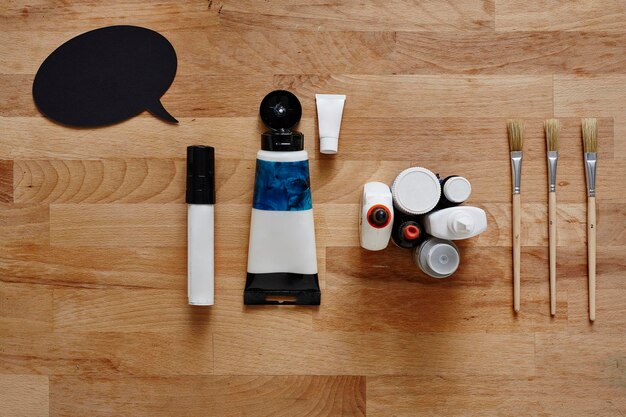
Influencers and Social Media: Catalysts for Change
The rise of social media platforms has been a pivotal factor in the widespread adoption and normalization of gender-neutral makeup among men. Influencers, from everyday users sharing their routines to celebrity figures openly embracing makeup, have created a powerful visual dialogue. These platforms provide safe spaces for experimentation and dispelling old myths, showcasing diverse interpretations of masculinity.
Content creators demonstrate techniques, review products, and share personal journeys, fostering a sense of community and acceptance. This peer-to-peer engagement bypasses traditional media gatekeepers and allows for more authentic and relatable portrayals of male beauty. The visual nature of platforms like Instagram and TikTok is particularly effective in demonstrating the subtle impacts of makeup, making it less daunting for newcomers.
- Demonstrating natural application techniques.
- Reviewing products tailored for men’s skin.
- Creating community spaces for male beauty enthusiasts.
- Challenging traditional beauty standards visually.
This organic, user-generated content is far more persuasive than traditional advertising for many younger consumers. It allows for a nuanced exploration of what makeup means to different individuals, rather than a top-down prescription of beauty ideals. The authenticity of these influencers resonates, driving curiosity and encouraging experimentation among their male followers, thus significantly expanding the market.
Established brands are now actively collaborating with male beauty influencers, recognizing their power to shape consumer perceptions and drive sales. This strategic partnership helps bridge the gap between traditional brand identity and the evolving modern consumer. It also allows brands to gather valuable feedback directly from their target demographic, leading to more responsive product development. This dynamic interplay between brands and influencers is accelerating the integration of gender-neutral makeup into the mainstream.
Challenges and Opportunities in the US Market
Despite the undeniable progress, the journey towards full mainstream acceptance of gender-neutral makeup for men in the US is not without its challenges. Societal norms, while loosening, still exert considerable pressure. Many men may feel hesitant to experiment due to fear of judgment or simply a lack of familiarity. The existing retail landscape is also adapting, as traditional beauty counters are often still heavily gendered in their presentation.
However, these challenges simultaneously present significant opportunities. The untapped market potential for male consumers is immense. Brands that successfully navigate these cultural nuances and offer genuinely inclusive products and marketing will gain a considerable competitive advantage. The opportunity lies in not just selling products, but in shifting cultural perceptions and making the use of cosmetics feel natural and empowering for all.
Online retail channels and specialized unisex beauty stores are emerging as critical avenues for distribution. They provide a discrete and comfortable shopping experience for men who may feel uncomfortable browsing traditional makeup aisles. This shift in retail strategy is paramount to capitalizing on the growing demand, ensuring products are easily accessible to the target audience.
Educating Consumers and Breaking Down Stigmas
A primary challenge, and thus an opportunity, lies in consumer education. Many men simply don’t know where to start with makeup or understand its potential benefits beyond theatrical applications. There’s a need for accessible, easy-to-digest content that demystifies product use, offers practical tips for natural application, and showcases the diverse ways makeup can enhance rather than conceal.
Breaking down existing stigmas requires a multi-faceted approach. This includes consistent, positive representation of men using makeup in media, open conversations about self-expression, and the creation of safe spaces for men to explore these interests without fear of ridicule. This educational and cultural effort will be crucial in broadening acceptance beyond early adopters.
- Providing beginner-friendly makeup tutorials.
- Highlighting the skin health benefits of certain products.
- Showcasing diverse male role models using makeup.
- Addressing misconceptions about makeup and masculinity.
Building confidence and competence through education is key. When men understand how to use products effectively and realize the subtle enhancements they can achieve, the perceived barrier to entry significantly lowers. This educational push, combined with increasing visibility and decreasing social stigma, will accelerate the mainstreaming of gender-neutral makeup for men in the US.
Moreover, the industry can leverage the growing interest in self-care and wellness among men. Positioning makeup as a component of a holistic self-care routine, rather than solely a cosmetic enhancement, can resonate deeply. Framing it alongside skin fitness, anti-aging, and overall well-being allows for a broader appeal, integrating it seamlessly into a modern man’s lifestyle.
The Economic Impact: Growth and Diversification
The economic implications of gender-neutral makeup’s rise are substantial. The beauty industry, traditionally dominated by products aimed at women, is now experiencing a significant diversification of its consumer base. This expansion translates into new revenue streams, increased product development, and a more robust, adaptable market. As more men enter the cosmetic space, their unique preferences drive innovation.
This economic impact extends beyond product sales. It influences advertising budgets, research and development investments, and even the creation of new job roles within the beauty sector. Brands are hiring consultants with expertise in male grooming, gender studies, and inclusive marketing, signaling a serious commitment to this growth area. The industry is responding to a real and expanding economic opportunity.
Investment and Innovation in Product Lines
The economic potential fuels significant investment into research and development. Companies are not just repackaging existing products; they are creating new formulations, application tools, and delivery methods specifically suited to the needs and preferences of male consumers. This includes exploring textures that feel lighter on the skin, packaging that is discreet and easy to use, and multi-functional products that simplify routines.
This innovation is not limited to makeup. It extends to complementary products like specialized cleansers, primers, and setting sprays that cater to the unique characteristics of male skin, or simply to products desired by a masculine user. The drive for gender neutrality pushes the entire industry to be more creative and inclusive in its offerings, benefiting a wider range of consumers.
- Development of multi-purpose makeup products.
- Ergonomic design for male-friendly applicators.
- Research into specific needs for diverse male skin types.
- Increased funding for inclusive beauty startups.
This growth and diversification signify a maturing market that is no longer confined by traditional boundaries. The influx of male consumers is not a fleeting trend but rather a foundational shift, positioning makeup as a tool for personal expression and confidence available to all, regardless of gender. This will lead to a more resilient and dynamic beauty industry overall. The economic incentive for inclusivity is undeniable, leading to a virtuous cycle of demand and supply.
The expansion into gender-neutral makeup also encourages collaborations across industries, such as fashion, technology, and entertainment, to create cohesive campaigns that resonate with a broader audience. This cross-pollination of ideas and resources further stimulates market growth and product experimentation, establishing gender-neutral beauty as a significant force in the global economy. It reflects a deeper cultural shift where identity is increasingly fluid and self-defined.
Future Outlook: Inclusivity as the New Normal
The trajectory for gender-neutral makeup in the US beauty industry points towards an increasingly inclusive future. What was once considered revolutionary or niche is steadily becoming normalized. The blurring of gender lines in cosmetics is not a temporary fad but a reflection of broader societal changes towards greater acceptance of individual expression and identity fluidity.
In the coming years, we can expect to see more ubiquitous availability of gender-neutral products across all price points, from luxury brands to mass-market offerings. The conversation will shift from “men using makeup” to simply “people using makeup,” demonstrating a fundamental evolution in how beauty is perceived and marketed. Inclusivity will transition from a marketing buzzword to an intrinsic part of brand identity and product development.
The Role of Policy and Social Acceptance
While market forces are powerful, policy and social acceptance also play a role in shaping the future. As societal norms continue to evolve, support for gender identity and expression from various institutions can further accelerate the acceptance of gender-neutral beauty practices. This includes educational institutions, healthcare providers, and media organizations.
A more inclusive public discourse around gender and beauty helps solidify the gains made within the cosmetics industry. When it becomes part of the mainstream conversation, the remaining stigmas gradually dissipate, making it easier for individuals to embrace self-expression through makeup without societal pressure. This creates a fertile ground for continued market growth and innovation, establishing true inclusivity as the new normal.
- Greater representation of male beauty in mainstream media.
- Educational initiatives promoting positive body image for all genders.
- Increased scientific research on diverse skin needs.
- Industry standards that mandate inclusive product testing.
The future holds the promise of a beauty industry that truly caters to everyone, offering choices based on individual needs and preferences rather than outdated gender categorizations. This will empower more men to explore makeup as a form of self-care and expression, further blurring the lines and enriching the tapestry of American beauty. The momentum suggests a future where personal choice reigns supreme, unburdened by gendered expectations.
This shift signifies a maturation of the beauty industry itself, moving towards a model that prioritizes individual empowerment and authentic self-expression over rigid conformity. As brands increasingly focus on genuinely universal appeal, the market will continue to expand, offering innovative solutions for diverse consumers. The integration of gender-neutral makeup into everyday life will become a testament to evolving societal values.
| Key Point | Brief Description |
|---|---|
| 👨🎤 Cultural Shift | Redefining masculinity allows men to embrace makeup for self-expression, expanding beyond traditional grooming. |
| 🧪 Neutral Formulations | Products focus on universal skin needs, moving away from gendered ingredients or marketing. |
| 📈 Market Growth | New brands and evolving strategies are tapping into the significant economic potential of male consumers. |
| 📱 Social Influence | Influencers and social media accelerate acceptance and provide education, normalizing male makeup use. |
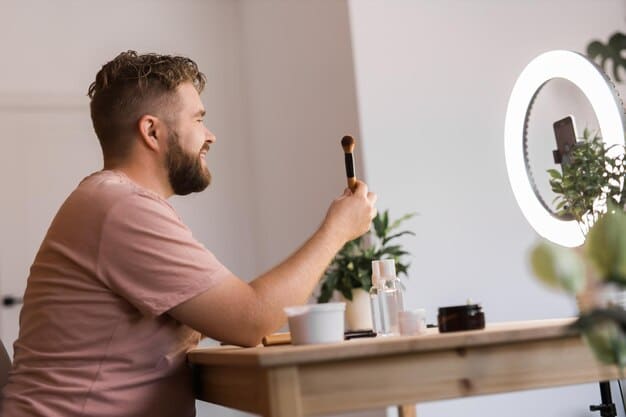
Frequently Asked Questions About Gender-Neutral Makeup for Men
Gender-neutral makeup refers to cosmetic products designed and marketed without specific gender associations. These products focus on universal skin needs and aesthetic enhancements, appealing to anyone regardless of their gender identity. They often feature minimalist packaging, versatile formulas, and aims to enhance natural features rather than conform to traditional gendered beauty ideals.
The increasing use of makeup by US men is driven by evolving concepts of masculinity, a desire for self-expression, and the normalization of male grooming. Social media influencers play a significant role in showcasing diverse male beauty, making makeup more accessible and less stigmatized. Men are using it for skin enhancement, blemish coverage, or simply as a form of personal care.
Yes, while skin biology is largely the same, traditional “women’s” lines often focus on dramatic transformations, and “men’s” lines are historically very limited. Gender-neutral makeup prioritizes versatile formulations, natural finishes, and effective ingredients suitable for all skin types and tones. The difference lies primarily in marketing and the absence of overt gendered messaging, promoting inclusivity from the outset.
Common gender-neutral makeup products for men include tinted moisturizers, concealers for blemishes or under-eye circles, brow gels for grooming and definition, and lip balms with a slight tint. The focus is often on subtle enhancements that improve skin appearance or define features without appearing heavily made-up. These products are popular for their ease of use and natural results.
The beauty industry is adapting by launching new brands entirely focused on gender-neutral products, and established companies are revising their marketing to be more inclusive. There’s a shift towards universal product concepts, minimalist packaging, and campaigns featuring diverse models. Retail channels, especially online, are also expanding to cater to this growing consumer segment, recognizing its significant economic potential and demand for accessibility.
Conclusion
The evolving landscape of the beauty industry, particularly in the US, reflects a profound societal shift towards inclusivity and individual expression. The blurring of lines in cosmetics, championed by the rise of gender-neutral makeup, is fundamentally reshaping how men interact with personal care and identity. This movement signals a future where beauty is not confined by antiquated gender norms but is a universal tool for confidence and self-enhancement, readily available and widely accepted for everyone.
